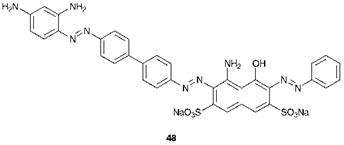The strategies leading to dyes with several azo groups are in essence extensions of the methods leading to disazo colorants. As the number of separate diazotisations and azo coupling reactions required for the synthesis of a polyazo dye increases, so does the number of potential strategies. There are a number of commercial trisazo dyes, most being brown or black direct dyes for application to cotton. There are five strategies leading to trisazo colorants, which may be illustrated using the accepted symbolism as:
(a) E — D Z — A
(b) E1 — D M E2
(c) A M1 M2 E
(d) A1 M Z — A2
(e) A1 Z — A2
T
A3
As an example of strategy (a), the synthesis of C. I. Direct Black 38,48, may be represented as follows:
m-phenylenediamine — benzidine H-Acid — aniline
A few azo dyes containing four, five and six azo groups, referred to respectively as tetrakisazo, pentakisazo and hexakisazo dyes, are known although they are progressively less important commercially and, naturally, the synthetic strategies are more complex. Also, because of the
|
|
increased likelihood of side-reactions, the products are increasingly less likely to be pure species.
 14 сентября, 2015
14 сентября, 2015  Pokraskin
Pokraskin 
 Опубликовано в рубрике
Опубликовано в рубрике 